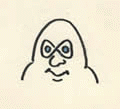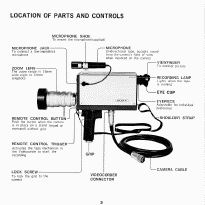New Synthesis
Portfolio Showcase : 1970 - 1980

Early jobs (aside from restaurant worker, substitute teacher & cab driver) included commercial & advertising art, film animation and community activism.
Then accessible Video and cable TV came together to create a new medium - and I discovered interactivity.
The Medium is the Message
Hand-held Video Cameras (most notably the Sony PortaPak) first appeared on the scene in the early 70's. The timing couldn't be more perfect. This cheap, "luggable" video camera recorded grainy B&W video on reel-to-reel tape.
A generation of self-styled "VideoFreaks" embraced the new technology as a tool for democratization, social activism and artistic expression.
During this decade I produced advocacy documentaries, performed video art pieces - Sometimes I even got paid for working in the media.
New Channels
Cable TV was originally just a convenient way to deliver decent reception of broadcast TV signals to out-of-the way places. It was also the leading edge of the movement towards interactivity in the home, the media empowerment of local communities and the deregulation of our dominant media monopolies.
An interesting place to be in those early days.
1970-1980
 Bryant Park Redesign
Bryant Park Redesign
Bryant Park, the large, lovely park behind the New York Public Library at 42nd Street was a popular spot for drug dealing. The W R Grace corporation funded an effort to make the space more attractive to the general public. The Project for Public Spaces was brought in to perform research on the problem and propose a redesign of the park layout. I directed a media crew and research team for PPS in the spring of 1981.
 Television News Talent Bank
Television News Talent Bank
Television News Research was a venture to provide a video library of newscasters to be used by local News Directors to identify and evaluate likely candidates for employment as on-air talent. As Editorial and Technical Manager I supervised a small video editing staff in the creation of a national video "talent bank" of newscasters - cross-referenced by region & market, as well as rated ... by me. I "discovered" several news media stars.
 The Worldgame
The Worldgame
Inventor, architect, engineer, mathematician, poet and cosmologist Buckminster Fuller proposed a “great logistics game” and “world peace game” (later shortened to simply, “the World Game”) to facilitate a comprehensive, anticipatory, design science approach to the problems of the world.
In the summer of 1979 I produced multimedia advocacy document of the 3-day workshop that focused on creating housing solutions.
 The Interactive Telecommunications Program
The Interactive Telecommunications Program
Originally housed in three shabby rooms above the venerable Bleeker Street Cinema in Greenwich Village, the ITP was the first post-graduate program to focus on the emerging Information Economy and the impending deregulation of the communications industries. . Nobody knew what it was going to become, so we got to explore it all: form, function, gadgetry, behavior, social and organizational change, global implications ....
 Automation House Cable TV Local Studio
Automation House Cable TV Local Studio
In 1977 Manhattan Cable TV designated 3 video facilities in NYC as "Local Injection Points" (LIP's) to produce local origination programming. Soon after I arrived in the city, I was lucky enough to be taken on as Lighting Director / Set Designer and occasional Production Director on the fulltime staff. (There weren't many paying jobs available in the upstart medium at that time.)
This is where I first met and worked with Bill Porter, who became my earliest collaborator when I formed The Communication Studio.
 Participatory Design Conference
Participatory Design Conference
I worked with local community groups from 1973 to 1980, documenting community organizing around the issues "liveable spaces", sweat equity, urban homesteading and advocacy in both Somerville, MA and New York City.
 Municipal Cable Channel 84
Municipal Cable Channel 84
By the early 70's cable TV systems were becoming common throughout the country.As an outspoken community advocate, I was selected by the local Community Cable Advisory Board and Mayor's office to head up one of the first community-run and operated cable TV stations in the United States.
 MIT Arts / Animation
MIT Arts / Animation
I was fortunate to be living in the Cambridge MA area in the mid-70's. As a community cable TV activist and new media wannabe, I often hung out around the emerging technology scene at MIT, specifically The Architecture Machine group, which later emerged under Nicholas Negroponte's visionary leadership as The Media Lab.
 Politics of Cable
Politics of Cable
In the Spring of 1975 - having worked with community leaders and stakeholders for more than a year - I finished my first significant video-documentary. The Community Cable Advisory Board and Public Access advocates used the video to spur education and advocacy about the cable situation within the local community.
Within a few months of its release Somerville Mayor S.Lester Ralph allocated federal CETA funding to establish a permanent community programming entity under local government auspices. The Community Cable Advisory Board unanimously selected me to head up The Municipal Cable Project.
 WGBH New Video Workshop
WGBH New Video Workshop
In the early 70's local PBS channel WGBH in Boston initiated a "studio" for experimental video in Watertown, MA with funding from the Rockefeller Foundation. Technical Director for collaborative creative productions, led field video research team for a cross-cultural children's TV show, provided technical assistance to local Boston area artists
 Lisberger-Ladd Animation / "Make a Wish"
Lisberger-Ladd Animation / "Make a Wish"
Animator for "Make a Wish", a children's program that aired on ABC. This was probably my first real (i.e. paid-to-be-a-professional) media job. I created short animation snippets for the show at newly-formed Lisberger-Ladd Studio in Boston. We were to take a word or phrase and animate it. Old-school: Film animation
 Amsterdam "Hair"
Amsterdam "Hair"
Spotlight operator & roadie for the Amsterdam, Holland, production of the pop musical. S*X & DR*GS & R*CK & R*LL. Wheeeeee!
 Frank's Men's Store
Frank's Men's Store
As a college student in 1969 and 1970 I wanted to see if I could actually do "professional" commerical art. And besides - I needed the money. Frank's Men's Store in nearby Medford Square was looking to get some fashion visuals into the local paper.

